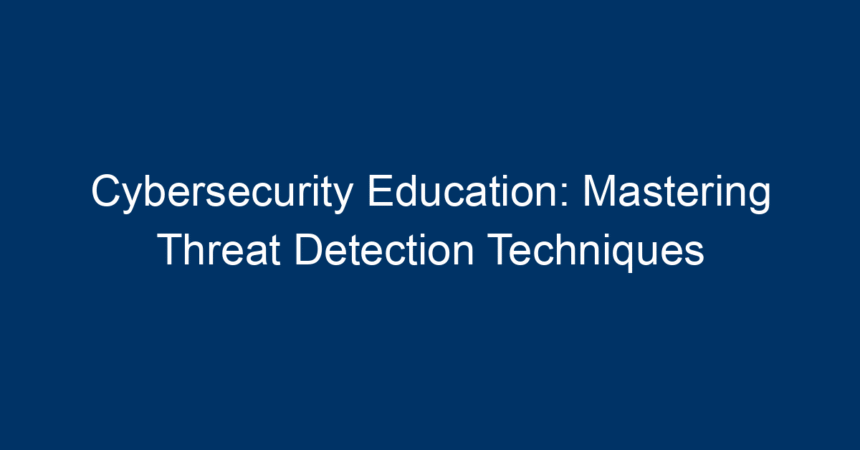In our increasingly digital world, the necessity for robust cybersecurity practices has never been more paramount. Cyber threats are evolving rapidly, posing significant risks to organizations and individuals alike. As these threats expand in complexity, so too must our defenses. This is where cybersecurity education comes into play, arming professionals with the skills needed to detect and thwart potential security breaches. In this article, we will dive into essential threat detection techniques, the importance of continuous learning in the cybersecurity field, and actionable insights that can bolster your defenses.
The Importance of Cybersecurity Education
Cybersecurity education serves as the foundation for a secure digital environment. With cybercrime projected to reach trillions in economic damages, understanding threat detection is crucial. Cybersecurity professionals need to stay ahead of cybercriminals by mastering a diverse skill set, ranging from technical know-how to analytical thinking.
-
Understanding Threat Landscapes: The first step in enhancing cybersecurity education is familiarizing oneself with the current threat landscape. Cybercriminals employ a variety of tactics, from phishing scams to advanced persistent threats (APTs). Recognizing these threats can significantly reduce vulnerability.
-
Skill Development: Cybersecurity education fosters critical skills such as risk assessment, incident response, and threat analysis. These skills not only improve individual capabilities but also contribute to stronger organizational defenses.
- Regulatory Compliance: Many industries face strict regulations regarding data protection. Cybersecurity education ensures professionals are aware of legal requirements, making compliance easier.
Key Threat Detection Techniques
Understanding and implementing effective threat detection techniques is essential for any cybersecurity framework. Here are some fundamental methods:
1. Intrusion Detection Systems (IDS)
Intrusion Detection Systems (IDS) monitor network traffic for suspicious activity. By employing a combination of signature-based and anomaly-based detection, IDS can identify potential threats according to known attack patterns and deviations from normal behavior.
-
Signature-Based Detection: This method relies on known patterns of harmful activity to flag potential breaches.
- Anomaly-Based Detection: This technique uses machine learning to identify unusual behavior in network traffic, enabling detection of previously unknown threats.
2. Security Information and Event Management (SIEM)
SIEM tools aggregate and analyze log data from multiple sources within an IT environment. By correlating this data, SIEM solutions can identify patterns indicative of security breaches.
-
Real-Time Monitoring: SIEM solutions provide real-time alerts, allowing for immediate action.
- Data Analysis: They enable deeper analysis, enhancing the understanding of attack vectors and improving future defenses.
3. Behavioral Analytics
Behavioral analytics utilize artificial intelligence to analyze user behavior and establish a baseline of normal activities. This approach helps identify anomalies that might indicate insider threats or compromised accounts.
- User and Entity Behavior Analytics (UEBA): By focusing on the behavior of users and devices, UEBA can detect deviations that signify potential threats.
4. Threat Hunting
Threat hunting is a proactive approach to identifying threats before they can cause damage. Trained cybersecurity professionals search for indicators of compromise (IOCs) within a network.
-
Hypothesis-Driven: Threat hunters generate hypotheses about where threats may exist and actively search for evidence.
- Continuous Process: This ongoing process helps create a deeper understanding of potential vulnerabilities and strengthens overall cybersecurity posture.
Continuous Learning and Skill Development
Given the dynamic nature of cyber threats, continuous learning is essential.
Online Courses and Certifications
Enrolling in online courses and certifications is one of the most effective ways to enhance your cybersecurity education. Certifications like CompTIA Security+, Certified Information Systems Security Professional (CISSP), and Certified Ethical Hacker (CEH) provide structured learning pathways.
-
Industry Recognition: These qualifications are recognized worldwide, increasing job prospects and professional growth.
- Hands-On Experience: Many online programs offer practical labs, enabling learners to apply theoretical knowledge in real-world scenarios.
Attending Workshops and Conferences
Participating in workshops and cybersecurity conferences such as Black Hat and DEF CON allows professionals to network, share knowledge, and learn from experts in the field.
-
Networking Opportunities: Building connections can lead to job opportunities and mentorship.
- Latest Trends: These events often showcase the latest tools and techniques in cybersecurity, keeping attendees up-to-date.
Community Involvement
Join cybersecurity forums and online communities. Engaging with fellow professionals helps share knowledge, best practices, and resources.
-
Collaboration: Working with peers can provide insights into different perspectives and solutions.
- Access to Resources: Many communities offer free resources, tools, and studies that can aid in skill enhancement.
Actionable Insights for Mastering Threat Detection
-
Prioritize Cybersecurity Education: Invest time and resources into ongoing learning. Whether through formal education, self-study, or community involvement, staying informed is key.
-
Adopt Threat Detection Tools: Leverage IDS, SIEM, and other security tools to enhance your detection capabilities. A multi-layered approach to security is always more effective.
-
Encourage Team Training: Provide opportunities for your team to improve their skills through workshops, training sessions, and certifications. A knowledgeable workforce is less vulnerable to attacks.
-
Develop a Threat Hunting Program: Encourage a proactive culture where team members consistently search for and address potential threats before they escalate.
- Stay Informed: Regularly review cybersecurity news and reports to understand evolving threat landscapes and adapt strategies accordingly.
Conclusion
In an era defined by rapid technological advancement, cybersecurity education is not just about acquiring knowledge; it’s about staying agile in the face of ever-evolving threats. Mastering threat detection techniques is a crucial aspect of this education, providing professionals with the tools they need to protect their organizations effectively.
By being proactive, engaging in continuous learning, and fostering a culture of awareness, both individuals and organizations can strengthen their defenses against cyber threats. Remember, every step taken towards enhancing your cybersecurity education is a step towards a safer digital future.




